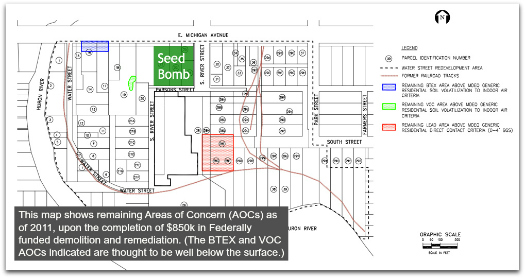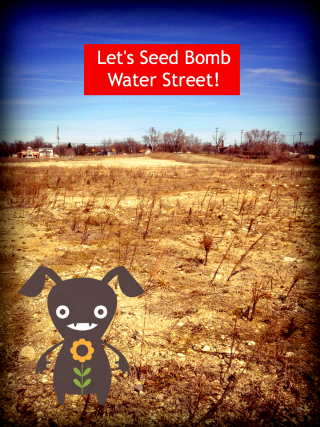
Since we last spoke about the idea of seed bombing Water Street, quite a bit has happened. Most notably, I’ve been in discussions with representatives of the City, as well as various people in the community who profess to know a thing or two about native plant species, bio-remediation, landscaping, and the like. What follow are my rough notes. Please let me know if you have any questions, or, better yet, suggestions as to how we might better move this project forward. And, as always, I’d love to know if you’d be available to help out. If so, please leave a comment… or join the Seed Bomb Water Street group that I just set up on Facebook.
 SITE SELECTION:
SITE SELECTION:
The above map (a larger version of the which can be found here) shows the remaining areas of contamination on the site, as well as the area that City Planner Teresa Gillotti and I have reached agreement on concerning seed bombing. The size of the parcel is, by my rough calculation, a little under 1.5 acres, and sits just west of River Street, right alongside Michigan Avenue. As you’ll notice, it’s a considerable distance from three three remaining areas of contamination (marked by green, red and blue on the map), so there shouldn’t be any risk, as some have warned, of the plants pulling toxins up to the surface. (It’s doubtful that it would have been an issue anyway, as the remaining contaminants, from what I’m told, are some 20-feet below the surface in the areas indicated, but we still thought that we’d play it safe and limit our activities to the dark green area shown above.) Another benefit of this site, in addition to being highly visible from the road, is that the soil here will likely be more conducive to plant growth than the property closer to Park Street, which is largely covered in crushed concrete. The City’s remediation consultant, as I understand it, still needs to sign off on the seed bombing, but no one that I’ve spoken with thus far seems to think there will be an issue.
CITY CONSIDERATIONS:
The City currently maintains the first 100 feet or so back from Michigan Avenue… which essentially means that they mow it about once a month. In exchange for their not mowing the plot in question, and killing the flowers and plants that spring forth as a result of our proposed activities, they have requested that we – the seed bombers – sign up to take care of this section of the Water Street parcel for one year. As it doesn’t sound terribly onerous, I don’t imagine it will be a problem to find volunteers to join me, but, unless I can field a team over the weekend, this initiative likely won’t move forward. As for what it entails, as I understand it, we’d have to pick up trash once a month or so, and make sure that the piece of land in question doesn’t become overrun by weeds, etc. Our application, according to City Planner Teresa Gillotti, would have to be signed-off on by the Recreation Commission prior to the seed bombing of the property, but, as luck would have it, it looks as though they’re meeting on April 11, and I’m told that, if we get the paperwork in on Monday, they’d be able to give us a decision at that meeting. So, if we can line up some volunteers in the next few days, this all might work out. (A copy of the City’s “Adopt-A-Park” form can be found here.)
TIMING:
Given the fact that we need to get these seed bombs deployed before our spring rain showers start in earnest, I think that we need to do this in the next three weeks or so. And, having now spoken with quite a few folks, there are two specific dates which seem as though they could make sense. The first is Saturday, April 20 – the day on which volunteers will already be gathering on Water Street to plant several hundred trees. And, the second is the evening of Wednesday, May 1 – when several folks are planning to be on Water Street, celebrating May Day. In either case, that doesn’t leave a lot of time to procure materials, and make seed bombs… So we need to get started ASAP, if we’re going to do this.
FLOWERS:
A number of people have shared thoughts on the kinds of seeds that we should include in the seed bomb mix. Following are some of the points which have been brought up thus far.
1. I think everyone agrees that we want to use native species. Not only is it the right thing to do, in terms of environmental stewardship, but it’s also practical, in that native plants require less human intervention.
2. Following along the same line of reasoning, it’s also been suggested that we stay away from the likes of the shasta daisy, queen anne’s lace, chickory, and daylillies, even though they do quite well here, and have important uses (contraceptive, food, drink, medicinal). True native plants, as Lisa Bashert reminds us, “provide an environment for communities of wildlife, and restore a natural balance in our local environment. They also make our PLACE here in SE Michigan uniquely beautiful and different from other locales.”
3. Lisa also suggests that we consider bees when choosing our plants, making sure that we include good nectar plants, which will help to sustain our local population of pollinators.
4. The folks in City government have asked that we not plant a field of sunflowers, as, when full-grown, they would obstruct the view of law enforcement officers patrolling near the site. It’s something that hadn’t occurred to me when I set out to do this, but I suppose that it makes sense that police officers would prefer to be able to see further into the site from Michigan Avenue, as people have been known to dump garbage, and worse, on the property. I don’t imagine that a random sunflower or two would be too bad, but, as they’ve made the request, I think we should steer clear of sunflower seeds.
5. It’s been suggested that, before deploying our seed bombs, that we should first remove the invasive species from the site, like buckthorn and garlic mustard.
6. Jesse Tack, of Whole Culture Repair suggests that we consider adding diakon radishes, parsnips, squash, and chard to the wildflower mix, saying that we should strive for a “polyculture of plants.”
7. Tack also suggests that add a myco inoculant (a root biostimulant to the seed ball mix.
8. Ben Connor Barrie, a graduate student in Natural Resources at U-M, suggests that we include butterfly milkweed in the mix, as it’s a small clonal perennial that does well in poor sandy soils. (Bees and other pollinators also love it, he says.) Lisa Bashert agrees, saying that they provide excellent bee forage. She suggests that we include swamp milkweed (hot pink) and the butterfly weed (bright orange), saying that they’re “a little more ornamental, and shorter than the regular light mauve, common milkweed.” Jeff Clark also suggests butterfly milkweed (Asclepias tuberosa). And, EMU professor Jim Egge adds that “Eradication of milkweed is thought to be a major cause of the precipitous decline in monarch butterfly populations in recent years.” So, I’d say that milkweed will likely make the cut.
9. Ben Connor Barrie also suggested Jerusalem artichoke, which is a perennial relative of the sunflower. Lisa Bashert seconds his suggestion, saying that Jerusalem artichoke, while tall, are are “more delicate and slender than cultivated sunflowers, and, as part of a mix, should not obstruct views.”
In addition to Jesse Tack, Lisa Bashert, Stefanie Stauffer and Bonnie Wessler, I have intentions to contact the folks at Ann Arbor’s Native Plant Nursery, Mason’s Wildtype, Ann Arbor’s Wild Ones chapter, the Michigan Botanical Club, the Michigan Native Plant Producers Association and the MSU Extension Service… and all of my friends who are certified Master Gardeners. My hope is, by next week at this time we can all come to some agreement as to the best mix possible for the site.
[There were other notes, on everything from the temperatures at which seeds germinate to the attraction of rodents, and I'd encourage those of you who are interested to follow the links above, and read through them as well.]
FUNDRAISING:
Until we know exactly which seeds we’ll be using, it’s hard to say. Joseph Yaroch, however, did some quick searching and found “wildflower seed mixes for Michigan” selling about $75 per pound, with a recommendation that one use about 10 pounds per acre. That, however, as Yaroch points out, is what one would need if one wanted a fully-seeded meadow in one year’s time, whereas we’d likely be happy to start teraforming with less, and see what happens over time, as these perennials spread. And, for all we know, the kinds of seeds that we decide to choose could be more costly. So, unless someone comes through with an offer to underwrite the whole thing, I think that we need to assume that this will cost us at least $500… which means that we need to start thinking of ways to raise some money.
And, here, in case you’re new to the concept of seed bombs, is a little tutorial.
And remember to join the Seed Bomb Water Street Facebook group, OK? …And invite your friends.


















